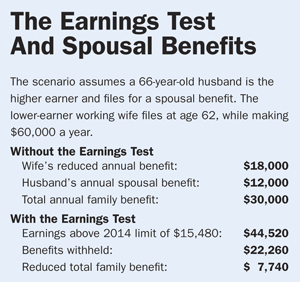Social Security Earnings Test Ensnares a Spouse
The test can decrease family members’ Social Security benefits based on your record.

You've likely heard of the dreaded “earnings test” for Social Security benefits. What’s sure to be a surprise, however, is that the earnings test squeezes not only your benefit but also family members’ benefits based on your record. And that could put a wrinkle in a couple’s plan to maximize household income by filing for a spousal benefit while delaying a higher earner’s benefit.
The earnings test hits working beneficiaries who are younger than full retirement age—age 66 for those born between 1943 and 1954. Under the earnings test, $1 of benefits is withheld for every $2 in earnings above the annual earnings limit of $15,480 in 2014. The earnings test disappears at full retirement age.
But a spouse who is full retirement age, as well as the younger wage earner, could be ensnared by the earnings test. Say the husband is the higher earner, age 66 and eligible for a full retirement benefit of $2,500 a month. He is waiting to take benefits until age 70 to earn delayed retirement credits of 8% a year—boosting his eventual benefit to $3,300 a month (see table below for the calculations).

Sign up for Kiplinger’s Free E-Newsletters
Profit and prosper with the best of expert advice on investing, taxes, retirement, personal finance and more - straight to your e-mail.
Profit and prosper with the best of expert advice - straight to your e-mail.
In the meantime, he’d like to file a “restricted application” for a spousal benefit on his lower-earning wife’s record to boost household income. (Under this rule, a spouse who is full retirement age can choose to file for his own benefit or for a spousal benefit.) His 62-year-old wife, who is still working, would need to apply for her own benefit so that he can claim the spousal benefit. She’s eligible for a benefit of $2,000 a month at full retirement age. By claiming four years early, her benefit would be reduced to $1,500, but her husband could claim the full spousal benefit of $1,000 a month because he is full retirement age.
Here’s where the earnings test puts the kibosh on the couple’s plan. If not for the earnings test, the couple would be eligible for a total benefit amount of $30,000 for the year.
In this scenario, the wife is earning $60,000, far above the earnings limit. The earnings test claims a chunk of the husband’s benefits as well as hers. The Social Security Administration would withhold $22,260 from the total family benefit, leaving the couple with $7,740 in benefits for the year. “If any benefits are left over, no matter how small, the Social Security Administration would pay them that benefit,” says Jim Blair, a former district manager for an Ohio Social Security office and a partner at Premier Social Security Consulting, in Sharonville, Ohio.
When the wife turns full retirement age, the Social Security Administration will adjust her benefit upward to make up for her forfeited benefit. The husband’s lost spousal benefits will be gone forever.

Test Gets Easier at Full Retirement Age
Some good news: The amount a couple can receive goes up in the year the younger wife turns 66. “There’s a special rule for the earnings test for the year you hit full retirement age,” says William Reichenstein, a professor of finance at Baylor University, in Waco, Tex.
In the year you hit full retirement age, a different formula applies: One dollar in benefits will be withheld for every $3 in earnings above $41,400 in 2014. The amount a couple receives would jump significantly.
The earnings test disappears starting the month you turn full retirement age. If the younger spouse has a birthday early in the year, the couple will get the full amount of benefits that much faster. “If her birthday is early in the year, there’s only a few months the earnings test applies,” says Blair.
If she turns 66 in March, for instance, the earnings test would apply only for January and February. She “wouldn’t have earned enough to exceed the test,” says Reichenstein. And as of her birthday month, she can earn as much as she likes without affecting her benefit or her husband’s spousal benefit.
Get Kiplinger Today newsletter — free
Profit and prosper with the best of Kiplinger's advice on investing, taxes, retirement, personal finance and much more. Delivered daily. Enter your email in the box and click Sign Me Up.

-
 Vaccines Medicare Covers for Free
Vaccines Medicare Covers for FreeThe U.S. is experiencing an outbreak of measles and is on track to have the most whooping cough cases since 1948; these vaccines Medicare covers for free can keep you safe.
By Donna LeValley
-
 Why You Need a Trusted Contact for Your Brokerage
Why You Need a Trusted Contact for Your BrokerageYour brokerage or bank needs someone to reach out to if it's concerned you're experiencing fraud or cognitive decline. That's where a trusted contact can help.
By John Waggoner
-
 457 Plan Contribution Limits for 2025
457 Plan Contribution Limits for 2025Retirement plans There are higher 457 plan contribution limits for state and local government workers in 2025. That's good news for state and local government employees.
By Kathryn Pomroy
-
 Medicare Basics: 11 Things You Need to Know
Medicare Basics: 11 Things You Need to KnowMedicare There's Medicare Part A, Part B, Part D, Medigap plans, Medicare Advantage plans and so on. We sort out the confusion about signing up for Medicare — and much more.
By Catherine Siskos
-
 The Seven Worst Assets to Leave Your Kids or Grandkids
The Seven Worst Assets to Leave Your Kids or Grandkidsinheritance Leaving these assets to your loved ones may be more trouble than it’s worth. Here's how to avoid adding to their grief after you're gone.
By David Rodeck
-
 SEP IRA Contribution Limits for 2025
SEP IRA Contribution Limits for 2025SEP IRA A good option for small business owners, SEP IRAs allow individual annual contributions of as much as $70,000 in 2025, up from $69,000 in 2024.
By Jackie Stewart
-
 Roth IRA Contribution Limits for 2025
Roth IRA Contribution Limits for 2025Roth IRAs Roth IRA contribution limits have gone up. Here's what you need to know.
By Jackie Stewart
-
 SIMPLE IRA Contribution Limits for 2025
SIMPLE IRA Contribution Limits for 2025simple IRA The SIMPLE IRA contribution limit increased by $500 for 2025. Workers at small businesses can contribute up to $16,500 or $20,000 if 50 or over and $21,750 if 60-63.
By Jackie Stewart
-
 457 Contribution Limits for 2024
457 Contribution Limits for 2024retirement plans State and local government workers can contribute more to their 457 plans in 2024 than in 2023.
By Jackie Stewart
-
 Roth 401(k) Contribution Limits for 2025
Roth 401(k) Contribution Limits for 2025retirement plans The Roth 401(k) contribution limit for 2025 increased, and workers who are 50 and older can save even more.
By Jackie Stewart